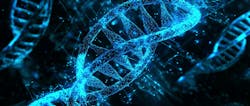The pathophysiology of ACS is summarized in
Figure 1. In the majority of cases, rupture of a coronary artery plaque is the initiating event. A low degree of localized inflammation is thought to be one of the precipitating events that causes plaque rupture. Infectious diseases such as with Chlamydia pneumoniae have been implicated as one source of inflammation.2 Plaque rupture is followed by the production of a blood clot, reduced blood flow through the affected coronary arteries and myocardial ischemia. Prolonged or permanent coronary artery occlusion produces irreversible myocardial necrosis. If the blockage, however, resolves within a few hours, either spontaneously or with early therapeutic intervention, only reversible ischemia occurs. While most of these patients will likely survive their ischemic episodes, they are at high short-term risk for myocardial infarction (MI) and cardiac death.
Figure 1 also lists the biomarkers and laboratory procedures pertinent to these stages. Inflammation is characterized by the release of C-reactive protein. Clot formation includes the activation of platelets, as denoted by the release of P-selectin and thrombosis, resulting in fibrinopeptide A. Reduced blood flow can be detected by myocardial perfusion imaging. The hallmarks for the diagnosis of MI and irreversible injury are increased concentrations of cardiac markers such as myoglobin, cardiac troponins T and I and Creatine Kinase MB (CK-MB) isoenzyme. Biomarkers of myocardial necrosis are not released during the first few hours after onset of chest pain with ACS. Until recently, there have been no markers that detect the presence of reversible myocardial ischemia.
The inability of current biomarkers to diagnose and rule out ACS at ED presentation has produced a dilemma for ED physicians and hospital administrators for chest-pain patients. On one hand, there is need to discharge patients with noncardiac causes of pain in order to conserve ED resources; on the other hand, inappropriate discharge of a patient with acute cardiac disease can lead to significant morbidity and mortality. Missed MI diagnoses from the ED are the major cause of malpractice lawsuits today.3 As shown in
Figure 2, there is an indirect correlation between the admission rate from the ED and the missed AMI rate.4 To minimize the number of wrongful discharges, many EDs have adopted a liberal admission policy for chest-pain patients.5
Given the limitations of troponin and CK-MB, there is considerable research effort in finding markers that are released during the reversible stages of disease. A reliable test for cardiac ischemia as an event would be important for early diagnosis and exclusion of acute cardiac diseases among ED patients who present with chest pain. Morrow, et al,6 listed ideal attributes for an ischemic biomarker:
- appears in blood early after onset of
ischemia; - is stable in blood;
- returns to baseline concentrations within 24 hours;
- is easy to measure;
- has good analytical performance;
- is inexpensive; and, most important,
- has high sensitivity and specificity.
Proper utilization of a reliable marker will have a major economic impact in the ED in terms of limiting inappropriate admissions of nonischemic patients and eliminating discharges of individuals at high cardiovascular risk.
IMA and the ACB test
Ischemia-modified albumin (IMA) refers to the alteration of serum albumin as a consequence of exposure to free radicals produced from ischemic tissues. The site of albumin modification is the N-terminal amino-acid sequences of albumin.7 The modified albumin exhibits a reduced capacity to bind to certain transition metals, such as cobalt. The Albumin Cobalt Binding (ACB) test was developed to measure IMA in serum samples.
Figure 3 illustrates the principle of the ACB test. Blood from a nonischemic individual contains albumin that largely exists in its native form. When a solution of cobalt is added to an aliquot of serum (panel A), Co+2 binds to unmodified albumin, and there is a low concentration of free metal ions. Blood from an individual with ischemia contains albumin that has been modified. When the same concentration of cobalt is added (panel B), the inability of the IMA to bind Co+2 results in a higher free concentration of the metal. Dithiothreitol is used to react with free Co+2 to produce a color that can be measured spectrophotometrically at 500 nm. The upper limit of normal for the ACB test is 85 U/mL. Unlike some cardiac markers, there are no race, age or gender differences in the reference range. The assay has a sensitivity of 14 U/mL and is only affected by extreme albumin concentrations ( 5.5 g/dL). This assay has been adapted to several common automated clinical chemistry analyzers.
Clinical utility of IMA
The clinical utility of any marker for myocardial ischemia is dependent on how quickly significant changes from baseline are observed after the onset of ischemia. For IMA, controlled animal studies are difficult to perform because the albumin modifications observed in humans do not occur in many experimental animals. The best human model is angioplasty, where transient ischemia is induced with inflation of the balloon catheter (>3 minutes).8 In this preliminary angioplasty study, results showed that albumin is modified within the first few minutes of ischemia and IMA remains increased for two to four hours thereafter, returning to baseline at six hours. Given that cardiac troponin and CK-MB are not reliably increased until about six hours after disease onset, IMA may cover the window of time before necrosis markers are useful.
This hypothesis was first examined in clinical trials of ED patients using the original World Health Organization9 and European Society of Cardiology/American College of Cardiology criteria10 for AMI11. The clinical study reported in the manufacturers ACB test package insert evaluated 208 high-risk patients (ACS prevalence=63%) presenting to the ED with clinical signs suggestive of cardiac origin. Blood was collected within one to two hours of presentation. ACS was diagnosed according to current guidelines in 63% of the study population. Results of cardiac troponin T (cTnT, cutoff 0.05 ng/mL) and the electrocardiogram (ECG) were compared against IMA. As shown in
Table 1, IMA alone had higher clinical sensitivity than either cTnT or ECG alone. When IMA was combined with the other tests, the sensitivity increased with ECG and with ECG and
cTnT.
The high prevalence of ACS in the aforementioned study does not mimic an emergency department practice of patients who present with chest pain. A second study of low-risk patients with a lower and more realistic ACS prevalence of 7% is ongoing, and final results will be reported at a later date. In a pilot study, IMA was again compared to cTnT and ECG (n=199 patients). The inclusion criteria were acute chest pain at presentation and undergoing a rest sestamibi myocardial perfusion imaging (MPI) examination within one hour of cessation of pain. Patients were diagnosed negative or positive for ACS according to current guidelines for diagnosis of myocardial infarction (STEMI and NSTEMI) and unstable angina. The sensitivity of IMA increased slightly to 86% (compared to the previous study) on a small number of ACS-positive patients. More importantly, the negative predictive value for IMA alone and in conjunction with ECG and cTnT increased to 97% and 100%, respectively.
The clinical specificity of IMA is not as high as either cTnT or ECG in either study (36% to 46% vs. 90+% for ECG and cTnT). Anecdotal evidence suggests that IMA may be increased in patients with stroke, end-stage renal disease and some neoplasms, but not trauma, autoimmune disease, hypoxia or skeletal muscle ischemia.12 As these other etiologies are associated with significant morbidity and mortality, it may be possible that IMA may be useful for detecting any ischemic event, which may justify admission of the patient for a detailed clinical examination. New clinical trials will be necessary to examine this possibility.
The sensitivity of the ACB test for ischemia was confirmed by other investigators who used a noncommercial version of the ACB test.13 The sensitivity and specificity were 88% and 94%, respectively, when samples from ischemic patients were compared against nonischemic patients. One possible explanation for the higher specificity of this study compared to previous studies is that in this most recent one, the nonischemic group included individuals who were generally healthy, and were not necessarily a cohort of subjects presenting with chest pain.
The clinical significance of an elevated IMA remains to be determined. A new clinical trial is about to start to determine if chest-pain patients at low risk for ACS but with a positive IMA result will benefit from low molecular-weight heparin. Previously, the ESSENCE trial had shown that administration of enoxaparin to patients with unstable angina and non-Q-wave MI reduced the incidence of death, myocardial infarction and recurrent angina by 3.5% (19.8% vs. 23.3%) over 30 days relative to unfractionated heparin treatment.14 There was, however, an increase in the incidence (11.9% vs. 7.2%) of minor bleeding (epistaxis, ecchymosis, hematoma or macroscopic hematuria) with enoxaparin use. In the new clinical trial, patients with a positive IMA will be randomized to receive enoxaparin (1 mg/kg s/c 12 hourly) or no enoxaparin. The inclusion criteria are subjects with chest pain at rest within two hours of ED presentation. The exclusion criteria are subjects with ST or non-ST-segment elevation myocardial infarction, those who are at high risk for hemorrhage or have a contraindication for enoxaparin use. The outcome measures will be 30-day all-cause mortality, nonfatal MI and recurrent angina requiring revascularization. The hypothesis is that low-risk patients with myocardial ischemia as determined by elevated IMA should benefit from low molecular-weight heparin therapy given in the ED. While patients with a falsely positive IMA value might not benefit from this therapy, the anticipated incidence of minor adverse effects is low (as shown in the ESSENCE trial).
The U.S. Food and Drug Administration recently approved IMA measured by the ACB test as an early marker to aid in ruling out ACS in low-risk patients. Data from the new trial mentioned above, however, may show the value of use of an elevated IMA for risk stratification and guidance of patient management (an indication not currently FDA-approved).
Figure 4 illustrates the putative role of IMA in combination with cardiac troponin and the ECG for patients who present to the ED with chest pain. Patients with ST-segment elevation or depression on ECG or a positive troponin have acute coronary syndromes and should be admitted and treated. Those with a nondiagnostic ECG or negative troponin are triaged, according to results of the ACB test for IMA. If IMA is negative, the patient should be discharged or monitored depending on his pre-test likelihood of ACS. If IMA is positive, the patient should be monitored or treated if the pre-test likelihood for ACS is high. Use of IMA (or another biomarker of ischemia that proves successful) would change how patients are managed in the ED.
Summary
Ischemia-modified albumin is the first biomarker for myocardial ischemia to be approved by the FDA. Other markers are being evaluated such as free fatty acids, pregnancy-associated plasma protein-A, glycogen phosphorylase isoenzyme BB, sphingosine-1-phosphate and whole blood choline. This area of clinical research will continue to grow, given the importance of detecting myocardial ischemia. Which marker or combination of markers will, ultimately, be the best approach awaits further research.
Alan H. B. Wu, PhD, works with the Department of Pathology and Laboratory Medicine, Hartford Hospital in Hartford, CT.
References
- McCaig LF, Burt CW. National Hospital Ambulatory Medical Care Survey: 2000 Emergency Department Summary. Centers for Disease Control and Prevention, National Center for Health Statistics: Hyattsville, MD, 2002.
www.cdc.gov/nchs/releases/01nes/visitemer.htm - Wong BY, Gnarpe J, Teo KK, Ohman EM, Prosser C, Gibler WB, Langer A, Chang WC, Armstrong PW. Does chronic
Chlamydia pneumoniae infection increase the risk of myocadial injury? Insights from patients with non-ST-elevation acute coronary syndrome.
Am Heart J 2002;144:987-994. - Freas GC. Medicolegal aspects of acute myocardial infarction.
Emerg Med Clin North Am 2001;19:511-521. - Graff LG, Dallara J, Ross MA, Joseph AJ, Itzcovitz J, Andelman RP, et al. Impact on the care of the emergency department chest pain patient from the chest pain evaluation registry (CHEPER) study.
Am J Cardiol 1997;80:563-568. - Wu AHB. Cardiac markers: cost effective triage for myocardial infarction admission and therapy.
Med Lab Observer 2002;34(6):36-40. - Morrow DA, de Lemos JA, Sabatine MS, Antman EM. The search for a biomarker of cardiac ischemia.
Clin Chem 2003;49:537-539. - BarOr D, Lau E, Rao N, Bampos N, Winkler J, Curtis CG. Reduction in cobalt binding capacity of human albumin with myocardial ischemia. Annual Meeting of the American College of Emergency Physicians, 1999.
- BarOr D, Winkler J, VanBenthuysen K, Harris L, Lau E, Hetzel F. Reduced cobalt binding of human albumin with transient myocardial ischemia following elective percutaneous transluminal coronary angioplasty compared to CK-MB, myoglobin and troponin I.
Am Heart J 2001:141:985-991. - Christenson RH, Duh SH, Sanhai W, Wu AHB, Painter P, Apple FS, et al. Characteristics of an albumin cobalt binding test for assessment of acute coronary syndrome patients: a multicenter study.
Clin Chem 2001;47: 464-470. - Joint European Society of Cardiology/American College of Cardiology Committee. Myocardial infarction redefineda consensus document of the joint European Society of Cardiology/American College of Cardiology Committee for the redefinition of myocardial infarction.
J Am Coll Cardiol 2000;36:959-969. - Wu AHB, Morris DL, Fletcher DR, Apple FS, Christenson RH, Painter P. Analysis of the Albumin Cobalt Binding (ACB) Test as an adjunct to cardiac troponin I for the early detection of acute myocardial infarction.
Cardiovasc Toxicol 2001;1:147-152. - Apple FS, Quist HE, Otto AP, Mathews WE, Murakami MM. Release characteristics of cardiac biomarkers and ischemia-modified albumin as measured by the albumin cobalt-binding test after a marathon race.
Clin Chem 2002;48:1097-1100. - Bhagavan N, Lai EM, Rios PA, Yang J, Ortega-Lopez AM, Shinoda H, et al. Evaluation of human serum albumin cobalt binding assay for the assessment of myocardia ischemis and myocardial infarction.
Clin Chem 2003;49:581-585. - Cohen M, Demers C, Gurfinkel EP, Turpie AGG, Fromell GJ, Goodman S, et al. A comparison of low-molecular-weight heparin with unfractionated heparin for unstable coronary artery disease.
N Engl J Med 1997;337:447-452.
June 2003: Vol. 35, No. 6
© 2003 Nelson Publishing, Inc. All rights reserved.





